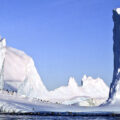
The Great Lakes may finally be poised to reach their potential as a new frontier of expedition cruises, planners said at a recent Seatrade Global cruise industry conference in Miami
“What’s old is new again,” said Bruce O’Hare, president of tour company Lakeshore Excursions. A century ago, every Great Lakes port was regularly hosting two or three excursion ships a day. The industry faded in favor of auto travel and only a few cruise vessels have sailed on the lakes in recent years, carrying mostly Europeans.
A renaissance in small ship cruising was on the horizon when the pandemic hit, including the Canadian Government’s COVID-inspired year-and-a-half long ban on cruise vessels in Canadian ports. Since then small expedition lines have been seeing a surge in demand and are drawing up itineraries that include cities but also wilderness exploration, especially along the Canadian shore of Lake Superior, O’ Hare said.
Among newcomers are Viking Expeditions, whose Viking Octantis is the largest Great Lakes expedition ship. Other players are Pearl Seas cruises from Maine to Toronto, SunStone Ships and Vantage Travel whose new Ocean Explorer have been Exploring the Great Lakes next year, joining Victory Cruise Lines’ Victory I and Victory II ,, and French luxury exploration company Ponant.

The Great Lakes is becoming a crossover destination, attracting both classic cruises to cities and big draws like Cleveland’s Rock & Roll Hall of Fame but also expedition ships that can go to small fishing villages or uninhabited islands with no port infrastructure needed. “That’s a game-changer for us,” O’Hare told the Seatrade panel.
Self-contained operations are a distinguishing feature of expedition cruising, pointed out session moderator Capt. Ben Lyons, CEO of EYOS Expeditions. This makes it easier to visit places that lack infrastructure. but he said there are still snags getting local approval for an expedition stop. For instance, on the Canadian side of the Great Lakes, government authorities generally allow the use of a ship’s own tenders to land on uninhabited islands. That’s forbidden in U.S. waters.
There’s also an issue of high costs of operating and tying up in Great Lakes ports. When asked if non-polar regions can ever equal the revenue of cruises to polar regions, Combrink said no. “Our operating margins will never be the same (as in polar exploring)” because of higher operating costs such as port fees and pilots.
And while the audience for travel to polar regions has traditionally been higher than for the inland seas, Combrink believes demand may be increasing as people remain uncertain about the safety of travel too far from home.
Because promotion costs are higher to fill itineraries with unfamiliar ports, Combrink urged destinations to stimulate interest by marketing themselves to the public as cruise attractions.
However, O’Hare, whose company markets more than 25 ports and makes sales calls to lines along with the Great Lakes Cruise Association, said he doesn’t expect much immediate support for consumer marketing from either Canada or the U.S.
The Great Lakes region has particular appeal now, though, by offering safe, close-to-home cruising for North Americans while being an intriguing place to discover for Europeans. O’Hare said the Great Lakes are attracting guests willing to pay more than the per diems of ocean destinations, citing a starting price of $15,000 for an eight-day Ponant cruise.
Even at those prices, many planned cruises for 2022 are already sold out, he claimed.






1 Trackback / Pingback
Comments are closed.